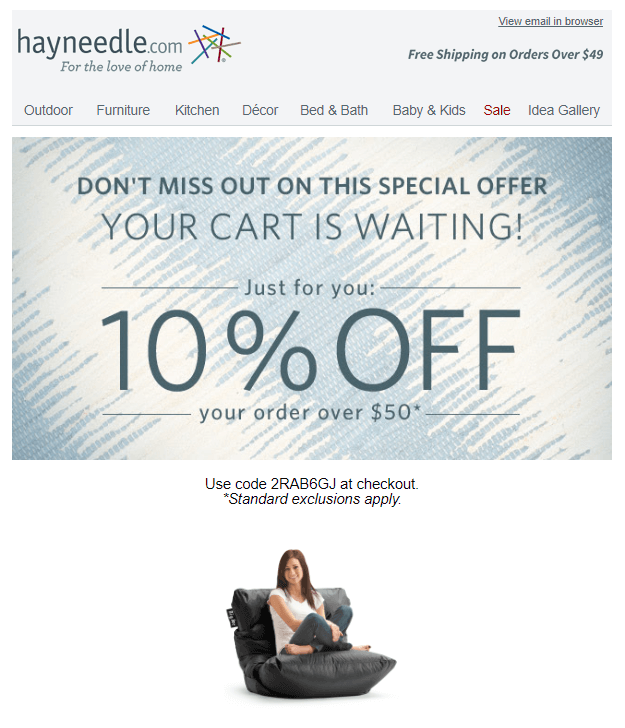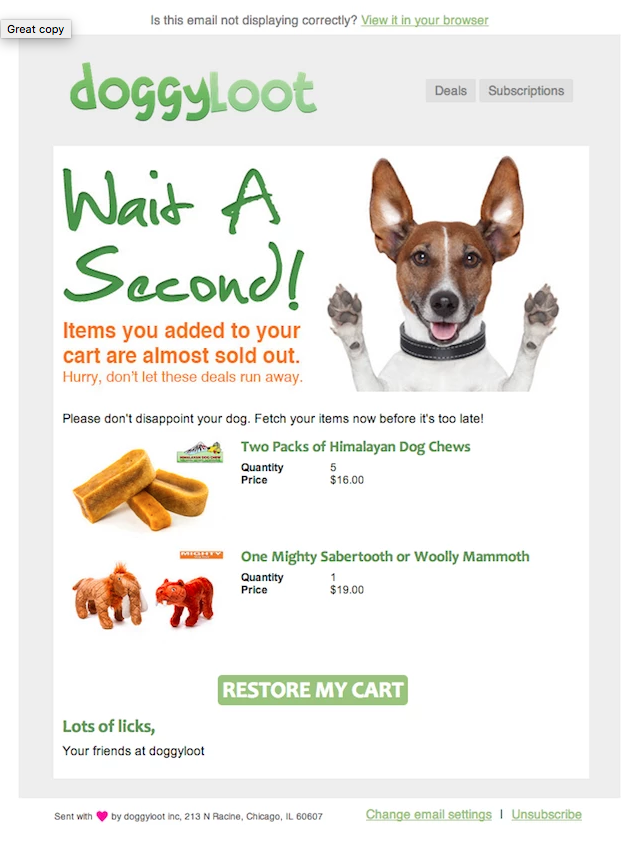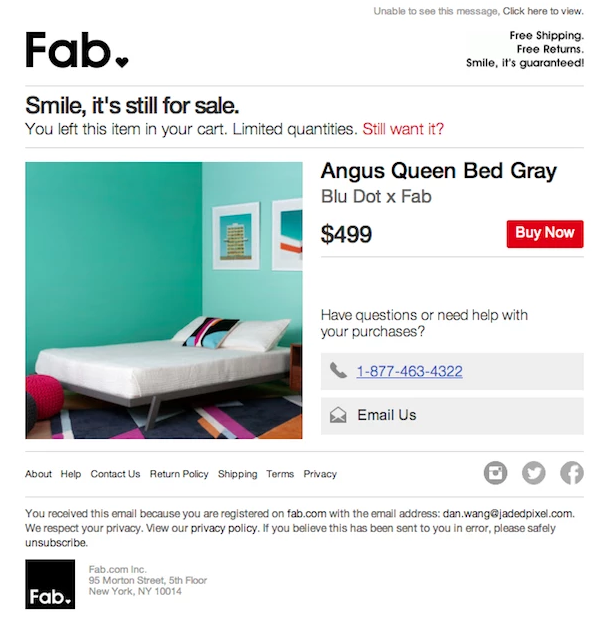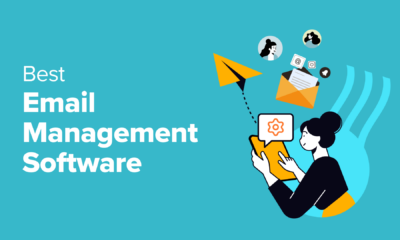EMAIL MARKETING
How to Put Together Interesting Abandoned Cart Emails (and Examples)
Online shoppers are notoriously fickle, and why shouldn’t they be?
There are so many options and avenues at their fingertips that there’s no sense in wildly committing to the first products they see. The multi-step checkout process allows them to toy with potential purchases — chalk certain items down as likely buys while they look around for alternatives.
From the standpoint of a seller, of course, this can be extremely frustrating. Just when a site visitor has heaped their cart with products and taken the first step in the checkout phase, it all goes up in smoke. The interested party disappears from the site, leaving behind all those items.
To combat this, every sensible online merchant automates cart abandonment emails to trigger when this happens. The goal? To tempt back the near-misses and turn those abandoned carts into sales. But they’re so common that they easily get dull and predictable. If what’s on your site doesn’t do enough to hold someone’s attention, you won’t get anywhere with a boring email.
So, if you want to optimize the results you get from your cart abandonment email campaigns, you need to make them more interesting.
What is an Abandoned Cart Email?
An abandoned cart email is an automated message sent to a prospect’s email address when they’ve put items in an online shopping cart and then left the page without making a purchase. The idea is to re-engage with a potential customer at an opportune time — namely, at the point where you know they’re interested in your product or service. Still, they need a bit more encouragement to actually seal the deal.
About 70% of shoppers will abandon their cart before checkout. Among the most common reasons for doing so are:
- High shipping costs
- Taxes or other added fees
- Being asked to create an account
- Delivery estimates are too slow
- An overly long or complicated checkout process
With abandoned cart emails, brands give themselves one last chance to show prospects their purchase is worth overcoming whatever hurdle originally turned them away from the site. It won’t convert every loss into a sale, but it will keep a few from falling through the cracks — and that can make a big difference in overall sales quarter after quarter.
Why are Abandoned Cart Emails Effective?
Of the abandoned cart emails that go out, 45% are opened, and about 11% lead to a completed purchase. That open rate jumps to 63% when you send three abandoned cart emails.
What makes this type of outreach so effective is that it serves as a well-timed reminder to a prospect about what they left behind. If they see a product after abandoning it and realize it’s still something they’re interested in, they may be willing to overlook whatever obstacle originally stood in their way. Brands can also sweeten the deal — and possibly increase their conversion rates — by throwing in a discount, such as free shipping or 10% off the purchase.
What are the Most Important Parts of an Abandoned Cart Email?
There are three major components to any abandoned cart email: the subject line, the body copy, and the personalization of the content.
The email subject line is largely what decides whether a prospect opens up the abandoned cart email in the first place. It should be catchy and on-brand, and it should get straight to the point of what the message is about. If there’s an incentive inside, that should be made clear in the subject line too.
Body copy is also key. It should be clear and concise, and it should make direct reference to the product(s) that the prospect left behind. This speaks to the third essential piece of the abandoned cart email puzzle, which is personalization, particularly in terms of the items. The ultimate goal is to lay out what the CTA is (finishing the checkout process) and then lead to that action as efficiently as possible.
When to Send Abandoned Cart Emails
Timing can be a huge deciding factor in whether an abandoned cart emails get the job done, with quicker sends usually yielding better results. If you wait too long, you risk letting the prospect forget about the shopping experience — and forget why they were that interested in the first place.
If we go off the three-email structure, your best bet is to send the first email as soon as possible — ideally within the first hour after abandonment — followed by a second email at least 24 hours after that and a third email after another 24 hours. If none of those emails are successful, let it go.
Ways to Measure Success
Tracking how many abandoned cart emails lead to sales is a clear marker of success, but it’s not the only one. Other email metrics that you should be looking at in regards to cart abandonment and related outreach include:
- Change in average order value lost. How much are abandoned carts costing you, and how is your abandoned cart email strategy impacting that cost?
- Click-through rates. How many abandoned cart emails are getting people to re-engage on the site, including those who re-engage and still don’t complete a purchase?
- Email capture rates. Your abandoned cart emails can lead to other important conversions, including having an individual supply their email address and opt-in to further engagement.
You should also be working on the back-end to try and identify what’s standing in the way of more sales and what you can do to fix it. Simplifying your checkout process alone could make a huge difference in how often items get left behind.
7 Ways to Make Your Abandoned Cart Emails More Interesting
1. Reiterate the Main Selling Points
Very commonly, cart abandonment emails will simply list the items left behind and advise that they’re still on offer — handy for prospective buyers who simply got distracted and forgot to finish their purchases, but not much use to those who actually decided against buying (for whatever reason). It makes no sense to simply repeat a failed tactic.
Regardless of the reason behind an email recipient failing to complete their order, you’re best served adding the big selling points for the listed products to their email. If they were already sold on them and simply had to leave for some emergency, the extra rhetoric won’t discourage them from continuing, and if they left because they decided otherwise, seeing the benefits clearly restated might just convince them that they were wrong to leave.
2. Throw In Some Small Incentives
There’s no shortage of competition in the eCommerce world, so retailers need to work extremely hard to stay viable. This tends to result in similar prices across the board — going too high will run you out of contention (people can easily shop around to find cheaper listings) while going too low will destroy your profit on items with razor-thin margins, to begin with.

The good news about that is that even a very modest discount can often be enough to convince someone to complete an order, particularly when it’s offered out of nowhere in a cart abandonment email. Or you could provide a different kind of incentive: a free gift included with the order, for instance.
3. Tell a Creative Story
Most eCommerce site copy comes across as fairly generic. You have basic product details, key features, customer reviews, warranty details, and relevant images. The persuasive burden for a given listing is placed on the visual presentation in combination with the innate appeal of the product — which means that two websites offering the same item will have very similar pages.
But you don’t have to settle for that, particularly in your cart abandonment emails. Even if you’re reluctant to get too creative with your on-page copy (perhaps fearing the consequences for SEO), you can easily get more relaxed with your email copy.
Allow some whimsy to creep in. Tell them how sad you are that they didn’t complete your order and that your adorable office puppy is looking heartbroken. A little humor (executed well) can really get people on your side, leading them to want to support your brand with their patronage.
4. Lean on FOMO Elements
Someone looks at the products on your site, nearly buys them, then decides against it. There’s clearly no rush driving their actions (at least pertaining to your site in particular). If you email them to say something that effectively amounts to “Hey, these items are still here! You forgot them!” then you’re not changing that.
You can change this using FOMO (Fear Of Missing Out), the rhetorical powerhouse that readily compels us to take action because we’re worried that something great will pass us by.

Instead of just listing the left-behind products, show their stock levels too, or simply note that they’re going quickly (even if they’re not). Lead the recipient to believe that their opportunity to buy isn’t indefinite. If they don’t act soon, their time will run out.
5. Alternatively, Play It Cool
FOMO is strong, but it doesn’t always work.
It’s really a hard-line gambit: if they’re really on the fence about wanting the item, the effort to hurry them may well cause them to conclusively decide against it. But that’s not the only negative effect it could have, because it might also lead them to dislike your business in general. People don’t like feeling hurried.
So if it’s more fitting of the circumstances, you can take the opposite tack and play it cool. Instead of leading them to think that they need to decide immediately, let them know that there’s no rush. They can change their mind whenever they want, and the great products (and great offers) will be there when they’re ready, no matter when (or how) they want to buy from you.

After all, assuming you’re using a multi-channel eCommerce platform, there’ll be nothing stopping them from changing their mind in the middle of the night and ordering from their phone through a chatbot in a messaging application (unlikely, perhaps, but completely possible).
This works as a display of confidence, shifting their perception of the situation and (possibly) driving them to want the products again. Think of a child refusing to do something they enjoy because their parents ordered them to — once that pressure goes away, they can make a free decision and follow their personal preferences.
6. Recommend Some Comparable Items
Suppose that nothing you do in your email, from restating the benefits of the abandoned items to offering a discount, has any effect on the recipient’s inclination to buy. They already made their mind up about those items, firmly concluding that they were no longer interested. But that doesn’t mean they lack interest in comparable items — maybe they just read some reviews and concluded that those specific products weren’t worth buying.
To cater to this, try listing some recommended products along with the abandoned items. If the stats of your online store show that 40% of the people who view a particular laptop go on to buy a totally different laptop, then that’s an obvious inclusion in a cart abandonment email to someone who left that first laptop in their cart.
7. Get the Right Automation Tools
Even if you have a fool-proof strategy for reigniting the interest of abandoned cart shoppers, you need the right tools to pull it off. Sign up for a free Benchmark Email account to test out our light email automation so you can automate email follow-up and our eCommerce Block feature, which allows users to promote their products via email. Both will help you turn abandoned carts into fresh sales for your business.
Sending cart abandonment emails isn’t enough in itself to make the most of your near-misses. You need to take the time to optimize them, setting them apart from those of your competitors — and these tactics will help you do just that.
Seen at: Benchmarkemail.com



















You must be logged in to post a comment Login